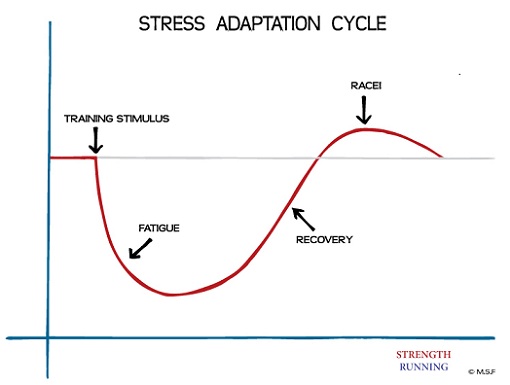Being a new runner is awesome. With big stretch goals and so much progress in front of you, it’s an exciting time to be a runner.
Can’t stop laughing #tistheseason #runbig2016
A photo posted by Jason Fitzgerald (@jasonfitz1) on
This month I wrote an article for Competitor Magazine on how beginners can get started with running. We covered several key questions:
- How much should I run per week?
- How can I get faster?
- Should I run races for time or just to finish?
Today I want to expand on this topic and help all of our new runner friends start runng on the right foot. See what I did there?! Puns are great.
After working with so many runners over the years – many of them brand new to the sport – I see a lot of classic mistakes being made over and over again. I want to help you avoid these common pitfalls and have more fun with your training.
Make sure you also read 9 Reasons You’re Running Slow (and how to fix them to get faster) if you’re not a beginner but have hit a plateau. It’s well worth the read for any runner who’s “stuck.”
Rule #1: Always Include These 3 Training Pillars
My coaching philosophy includes a simple rule: at no point should you ever get too far away from any one element of training.
What exactly does that mean? Well, it means you should almost always include these things in your running every week:
- long run
- faster workout
- strides
These aspects of running are fundamental. They form the foundation of running fitness – skip them at your peril.
A long run is the best workout for developing general endurance. And since new runners are most limited by their lack of endurance, the long run should be a consistent staple in your weekly schedule.
It doesn’t matter if your long run is 5 or 20 miles – the principle is to run a consistent long run that’s about 30-50% longer than your average run. So if you run 20 miles per week in four runs, that might be split into four runs of 4, 4, 5, and 7 miles.
Don’t get hung up on percentages (they’ll vary widely) but instead on running one run per week that’s a few miles longer than any other run.
The same is true for a faster workout. It doesn’t need to be a grueling session where Uncle Rhabdo chases you around the track (actually, that’s a terrible idea!).
Instead, focus on a relatively simple fartlek or tempo workout. Run fast, but controlled. Focus on running smooth. Get comfortable running fast. The more difficult workouts will come later as your training age increases.
Finally, strides are fundamental. They’re building blocks for speed and efficiency and make the transition to harder training significantly easier.
Every runner should do them at least twice per week!
Rule #2: Be Patient

Building fitness takes time. It takes weeks to recover from and properly adapt to any given workout. And it takes months and years to make significant progress.
Too often, beginners rush into training that’s simply too advanced.
…they try to tackle a marathon after being a runner for only 6 months…
…they attempt to train for a 7-minute improvement in the 10k in just two months…
…they increase their mileage too quickly, going from 0 – 30 in just a few weeks…
Just the other day I wrote a training plan for a runner who’s running a marathon in 17 weeks. Her current long run is a mere 5 miles… do you really think she’s ready to train for a 26.2 mile race?
Patience is the name of the game. And it’s why it’s a central lesson in my injury prevention philosophy.
Consider this: you might be impressed with my 2:39:32 marathon PR (it’s really not that fast…). But I didn’t run a race longer than 8km until 9 years after I started running. I ran track and cross country in high school and college, working on other important skills first:
- speed (improving as much as possible in races from 800m – 8,000m)
- mental toughness (you think a marathon is hard? Try racing a mile!)
- consistency (running 8-10 times per week was routine)
You don’t have to follow this formula. But I firmly believe that beginners should focus on short races in the first few years of their career before transitioning to longer races.
Races like the half marathon and marathon are long. They put the body under enormous stress and require extended recovery time. Dont jump into that before you’re adequately prepared!
For more lessons like this, sign up for our beginners email course
Rule #3: Be an Athlete, Not Just a Runner
In college, I used to get frustrated when my coaches assigned all this other “stuff” – running drills, skipping, lifting workouts, dynamic stretches.
I was a runner and I just wanted to run!
Now I recognize the enormous importance of all this work. Just think: basketball players don’t just play games of basketball. They practice every element of the game and focus on being a phenomenal athlete.
As a runner, you must do the same if you’re interested in improving and running fast.
Runners don’t just run, they also:
- practice dynamic flexiblity exercises to help them warm up before a run
- build a strong core
- perform runner-specific strength exercises
- Run really fast regularly (with strides or hill sprints)
All of these extras – which I don’t actually consider extras – help you become a better athlete with more agility, balance, strength, and flexibility.
They help you build a strong foundation of athleticism. Combine that with the fitness gained from relatively high mileage, consistent long runs, and appropriate speed workouts, and you’ll have a rock solid foundation.
And with a good foundation, you can build one helluva house.
My Little Secret…

Something I don’t often talk about is that I help runners set enormous personal bests because I have them train like elite runners.
But my runners aren’t covering 100+ miles per week or running grueling track sessions – that’s not what I mean.
Instead, I use the same principles that help make the world’s best the world’s best, and apply them to recreational runners.
Elite runners run high mileage. So I have my runners run higher mileage than they normally do (within their means, of course).
Elite runners run fast frequently. So do my runners – in appropriate workouts for their personal ability.
Elite runners lift weights, sprint, warm up dynamically, and run a long run every weekend. And my runners do, too.
The beauty of running is that training is scaleable. You can scale workouts or mileage up or down, making it accessible for even someone just starting to run.
If you’re a beginner, forget the standard way of doing things:
- running really slow all the time
- doing the same distance on most days (at the same pace)
- just worrying about “getting the miles in”
There’s a better way to do things and in this article, you’ve learned three strategies to give your training a big upgrade.
If you want more, get our free beginners course and I’ll show you:
- The mindset and high-level training strategies to help you succeed
- Specific workouts and strength routines to improve your fitness
- Niche topics like fueling, injury prevention, and speed development
Want it all? Just sign up here and the first lesson will be on its way soon.